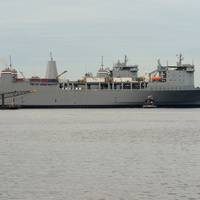US Ship 'Cape Ray' Neutralizes Syrian Sarin
All 581 metric tonnes of a precursor chemical for sarin gas that were removed from the Syrian Arab Republic and trans-loaded onto the U.S. Maritime Vessel Cape Ray in early July, have been destroyed with neutralisation technology aboard the ship while sailing in international waters of the Mediterranean Sea, informs the Organisation for the Prohibition of Chemical Weapons (OPCW). The precursor chemicals - methylphosphonyl difluoride, or DF - were neutralised with two Field Deployable Hydrolysis Systems (FDHS) that were installed on the Cape Ray for the purpose of destroying the most dangerous chemicals in Syria’s stockpile. The FDHS units mix the chemicals with fresh water and reagents and then heat the mixture, which reduces the toxicity of the chemicals by at least 99.9 percent.
US Cargo Ship to Load Syrian Chemical Agents Soon
An American cargo ship, the 'Cape Ray' converted into a mobile chemical weapons destroyer is expected to take charge of some of Syria's most dangerous materials next week, a U.S. defense official said. Syria on Monday handed over the remaining 8 percent of a total 1,300 tonnes that Syria declared to the Organisation for the Prohibition of Chemical Weapons (OPCW). The handover had faced repeated delays, leaving the Cape Ray docked in southern Spain awaiting a green light to proceed. Its mission now is to transform toxic agents into a much less poisonous soup of chemicals, ready for disposal back on land. The Cape Ray's crew were given word on Monday that they needed to be ready to depart Spain in the coming days for southern Italy's Gioia Tauro port…
Ship Ready to Destroy Syria's Chemical Arms at Sea

Experts on board a cargo ship transformed into a multimillion dollar chemical weapons destroyer said on Thursday they were ready to start working on Syria's stock of toxic arms in the middle of the Mediterranean as early as May. Now they just have to hope the weather holds and Damascus delivers on time. Former container vessel Cape Ray, docked in southern Spain, has been fitted out with at least $10 million of gear to let it take on about 560 metric tonnes of Syria's most dangerous chemical agents and sail them out to sea, said officials.
USCG Admiral Testifies on Chem Facility Security
WASHINGTON - Coast Guard Director of Port Security, Rear Adm. Craig E. Bone, testified today on chemical facility security before the Senate Homeland Security and Governmental Affairs Committee. “Considering the vast economic utility of our ports, waterways and coastal approaches, it is clear that a terrorist incident against a facility in our marine transportation system could have a disastrous impact on public safety, the environment, our nation’s economy, and international trade. Such an incident, if it were to occur in a strategic port, could also threaten our military mobilization capabilities. An incident at one of the 350 chemical…
Coast Guard Admiral Testifies on Chemical Facility Security
Coast Guard Director of Port Security, Rear Adm. Craig E. Bone, testified today on chemical facility security before the Senate Homeland Security and Governmental Affairs Committee. His written statement submitted for the record, follows. "Good morning Madam Chairperson and distinguished members of the Committee. It is a pleasure to be here today to discuss the U.S. Coast Guard’s role in securing the chemical facilities on the navigational waterways of the United States. The men and women of the U.S. Coast Guard and the Department of Homeland Security remain committed to improving maritime homeland security each and every day through continued interagency cooperation and assistance from our partners at the local, state and international levels, as well as maritime industry stakeholders.







